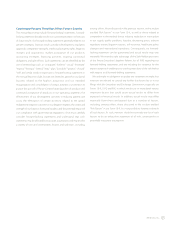Medtronic 2008 Annual Report Download - page 58
Download and view the complete annual report
Please find page 58 of the 2008 Medtronic annual report below. You can navigate through the pages in the report by either clicking on the pages listed below, or by using the keyword search tool below to find specific information within the annual report.
1. Summary of Significant Accounting Policies
Nature of Operations Medtronic, Inc. (Medtronic or the Company) is the
global leader in medical technology — alleviating pain, restoring health
and extending life for millions of people around the world. The
Company provides innovative products and therapies for use by
medical professionals to meet the healthcare needs of their patients.
Primary products include those for cardiac rhythm disorders,
cardiovascular disease, neurological disorders, spinal conditions and
musculoskeletal trauma, urological and digestive disorders, diabetes
and ear, nose, and throat conditions.
The Company is headquartered in Minneapolis, Minnesota, and
markets its products primarily through a direct sales force in the
United States (U.S.) and a combination of direct sales representatives
and independent distributors in international markets. The primary
markets for products are the U.S., Western Europe and Japan.
Principles of Consolidation The consolidated financial statements
include the accounts of Medtronic, Inc., and all of its subsidiaries. All
significant intercompany transactions and accounts have been
eliminated. The principles of Financial Accounting Standards Board
(FASB) Interpretation (FIN) No. 46 (revised December 2003), “Consolidation
of Variable Interest Entities” and Accounting Research Bulletin (ARB)
No. 51, “Consolidated Financial Statements” are considered when
determining whether an entity is subject to consolidation.
Fiscal Year-End The Company utilizes a 52/53-week fiscal year, ending
the last Friday in April. The Company’s fiscal years 2008, 2007 and 2006
ended on April 25, 2008, April 27, 2007 and April 28, 2006, respectively,
all of which were 52-week years.
Use of Estimates The preparation of the financial statements in
conformity with accounting principles generally accepted in the U.S.
(U.S. GAAP) requires management to make estimates and assumptions
that affect the amounts reported in the financial statements and
accompanying notes. Actual results could differ materially from
those estimates.
Cash Equivalents The Company considers highly liquid investments
with maturities of three months or less from the date of purchase to be
cash equivalents. These investments are carried at cost, which
approximates fair value.
Investments Investments in marketable equity securities and debt
securities are classified and accounted for as available-for-sale (AFS) at
April 25, 2008 and April 27, 2007. AFS debt securities are recorded at fair
value in both short-term and long-term investments and AFS equity
securities are recorded at fair value in long-term investments on the
consolidated balance sheets. The change in fair value for AFS securities
is recorded, net of taxes, as a component of accumulated other
comprehensive (loss)/income on the consolidated balance sheets.
Management determines the appropriate classification of its investments
in debt and equity securities at the time of purchase and reevaluates
such determinations at each balance sheet date.
Certain of the Company’s investments in equity and other securities
are long-term, strategic investments in companies that are in varied
stages of development. The Company accounts for these investments
under the cost or the equity method of accounting, as appropriate. The
valuation of equity and other securities accounted for under the cost
method considers all available financial information related to the
investee, including valuations based on recent third-party equity
investments in the investee. If an unrealized loss for any investment is
considered to be other-than-temporary, the loss will be recognized in
the consolidated statements of earnings in the period the determination
is made. Equity securities accounted for under the equity method are
initially recorded at the amount of the Company’s investment and
adjusted each period for the Company’s share of the investee’s income
or loss and dividends paid. Equity securities accounted for under both
the cost and equity methods are reviewed quarterly for changes in
circumstance or the occurrence of events that suggest the Company’s
investment may not be recoverable. See Note 5 for discussion of the
gains and losses recognized on equity and other securities.
Accounts Receivable The Company grants credit to customers in the
normal course of business, but generally does not require collateral or
any other security to support its receivables. The Company maintains
an allowance for doubtful accounts for potential credit losses.
Uncollectible accounts are written-off against the allowance when it is
deemed that a customer account is uncollectible. The allowance for
doubtful accounts was $99 at April 25, 2008 and $160 at April 27, 2007.
Inventories Inventories are stated at the lower of cost or market, with cost
determined on a first-in, first-out basis. Inventory balances are as follows:
April 25, 2008 April 27, 2007
Finished goods $ 784 $ 753
Work in process 250 209
Raw materials 246 253
T o t a l
$ 1,280
$ 1,215
Property, Plant and Equipment Property, plant and equipment is stated
at cost. Additions and improvements that extend the lives of the assets
are capitalized while expenditures for repairs and maintenance are
expensed as incurred. Depreciation is provided using the straight-line
Notes to Consolidated Financial Statements
(dollars in millions, except per share data)
54 Medtronic, Inc.
























